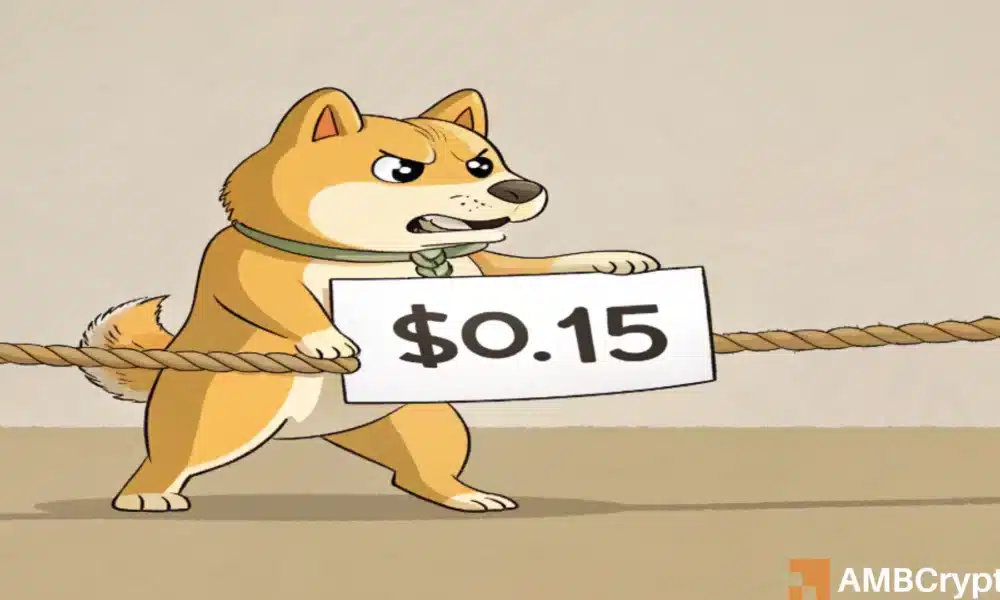Dogecoin’s Price Dynamics: A Deep Dive into Support Levels and Market Sentiment
As Dogecoin (DOGE) sits precariously around its $0.15 support level, an intense examination is underway concerning its resilience against the wave of sell-side pressure that has emerged in the cryptocurrency market. A striking 570 million DOGE have recently departed from whale holdings, indicating a significant capitulation that cannot be ignored. This has caused the Spent Output Profit Ratio (SOPR) to turn red, signaling that every coin being moved is at a loss, reflecting a noticeable decline in the once-roaring FOMO (fear of missing out) that characterized prior market conditions. However, amidst this bearish trend, DOGE has managed to limit its weekly decline to just 1.50%, suggesting that there might be buy-side strength at play, potentially driven by retail and mid-tier investors willing to absorb sell-side liquidity.
Despite the temporary stability at the $0.15 mark, the fundamental question remains whether this could represent a true market bottom or if it is merely a lull before another downturn. Over the past week, Dogecoin has retraced significantly, having dropped approximately 70% from its previous peak of $0.49 observed in November 2024. This dramatic descent has resulted in a growing number of Short-Term Holders (STHs) realizing unrealized losses, consequently liquidating their positions to minimize losses or break even. According to recent data, the STH cohort, which notably accounted for about 17.47% of DOGE’s circulating supply on January 17, has reduced their holdings from the local top of $0.41 down to just 6.5%, further accentuating the challenges faced by short-term investors in this bearish climate.
Furthermore, the decline in supply attributable to STHs coincides ominously with the reported negative SOPR, reinforcing the notion that a significant percentage of these holders are exiting the market. This growing uncertainty among STHs and whale investors gives rise to concerns about the long-term sustainability of the $0.15 support zone, which now appears increasingly vulnerable to further downward movements. The overall market sentiment is clouded with caution, making it difficult to confirm whether Dogecoin is nearing a bottom or is about to make yet another leg downwards.
Despite these challenging conditions, there exists an intriguing dichotomy within Dogecoin’s market structure. While STHs capitulate in the face of declining prices, a subset of committed long-term holders appears to be undeterred by the market turmoil. Observations show that the Hodler Net Position Change turned positive congruently with the recent rally to $0.41, indicating net accumulation during periods dominated by market euphoria. Notably, long-term holders saw their proportion of DOGE holdings increase from 28% to 32%, reinforcing their influence as a dominant group during this market correction.
Moreover, retail investors seem to be stepping in as a stabilizing force. Recent spot market flows reveal net outflows of about 16.48 million DOGE in correlation with recent price adjustments to $0.14, suggesting that retail wallets are actively accumulating coins to soak up the excess supply from exiting STHs and whale accounts. This dynamic reflects a nuanced tug-of-war within the market, whereby strong hands continue to accumulate while weaker hands capitulate under pressure. It remains to be seen whether this retail absorption will be sufficient to mitigate the broader sell-side pressure that has characterized recent market sentiment.
The resilience of long-term holders and their willingness to accumulate during downturns offers a potential beacon of hope for a market recovery. However, the road to a lasting upward movement hinges on the complete absorption of existing sell-side liquidity. Without this critical transition, the $0.15 support level may merely represent a fragile equilibrium rather than an entrenched market reversal. As Dogecoin navigates this turbulent landscape, investors are urged to remain vigilant regarding prevailing market trends and sentiment shifts that could significantly impact price dynamics.
In summary, while Dogecoin currently displays signs of resilience around crucial support levels, the overarching narrative is one of uncertainty. The collective sentiment among market participants—from whale capital to the retail investor—paints a complex picture of a market grappling with significant adjustments. As both short-term and long-term holders navigate their strategies in light of these realities, the outlook for Dogecoin remains a keen area of interest for investors aiming to capitalize on future price movements.










![Memecoin [MEME] Surges 42% in 24 Hours – Is It a Bull Trap or a New Trend?](https://icoinmarket.com/wp-content/uploads/2025/04/Gladys-71-1000x600-450x270.jpg)





